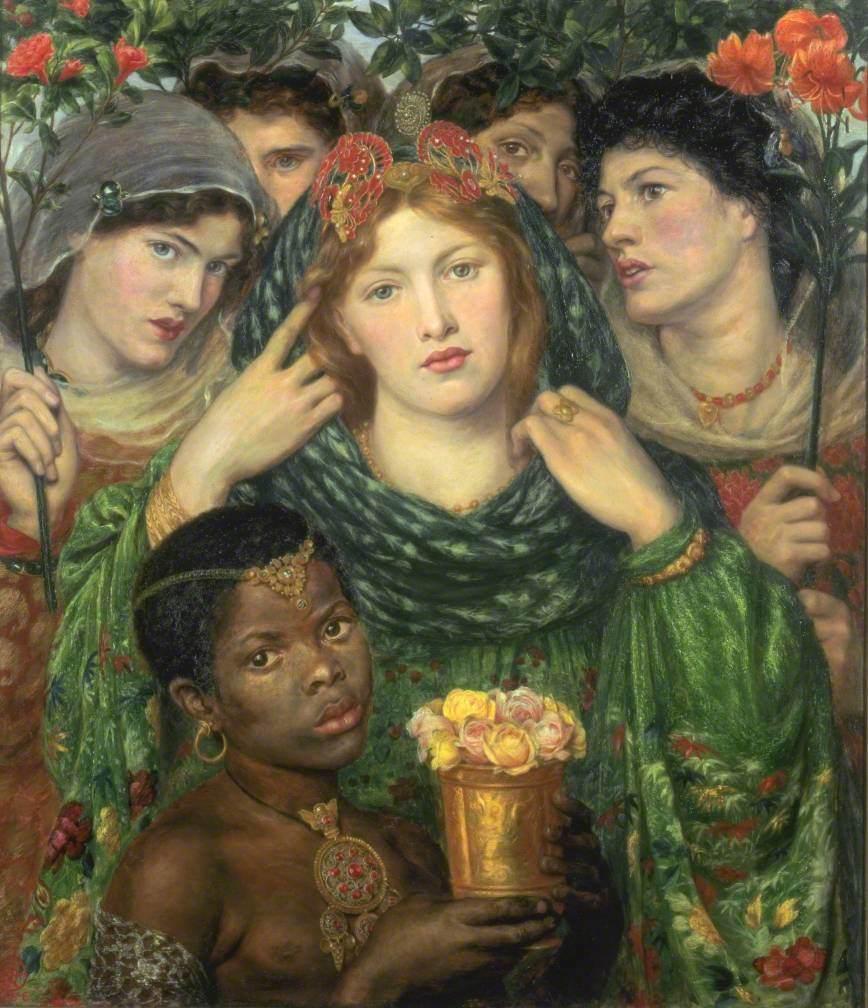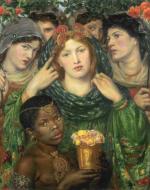Created by Dhruvi Soni on Sun, 10/25/2020 - 00:41
Description:
The Beloved was inspired by the Song of Solomon or the Song of Songs. The Song of Solomon is a biblical text in which a man and woman exchange love poems. (The Editors of Encyclopedia Britannica) The poems describe the beauty of the woman, who is the groom’s object of affection. The text has been interpreted as allegorical, dramatic, cultic, and literal. The allegorical interpretation states that the text is a metaphor for God’s love for Israelites. (The Editors of Encyclopedia Britannica) The dramatic interpretation states that the man and woman are enacting a dramatic love story through their letters. (The Editors of Encyclopedia Britannica) The cultic interpretation states that the poems demonstrate the Sumerian and other Mesopotamian people’s practice of marriage. (The Editors of Encyclopedia Britannica) Lastly, the literal interpretation states that the love poems do not contain any religious associations and only represent the love between a man and a woman. (The Editors of Encyclopedia Britannica)
Rossetti’s The Beloved does not appear to interpret the Song of Solomon through the allegorical and cultic interpretation. The allegorical interpretation can be rejected because there are no religious symbols in the painting that represent the God’s love for Israelites. Similarly, the cultic interpretation can be rejected because the painting represents the traditions of Victorian Era marriages. (Bentley 359) For example, the bride is wearing a tiara on top of her veil, which was a common bridal tradition in the Victorian Era. For these reasons, the Beloved appears to be created from a literal and dramatic interpretation of the Song of Solomon.
One can observe the literal interpretation of the Song of Solomon throughout the painting. The bride is displaying her love for her beloved with her blush. Her blush is representative of love because usually, individuals blush when they are with someone they are interested in. The bride is also showcasing her love for beloved by wearing red lipstick and a red tiara because red is often used to symbolize love. Red is also present in the bridal party, from the bridesmaids' flowers to the bridesmaids’ dresses to the necklace worn by the child and in the necklace worn by the bridesmaid on the far right with the red flowers. Therefore, Rossetti has represented the literal interpretation of the Song of Solomon in the Beloved.
The dramatic interpretation of the Song of Solomon can also be observed in the painting. Rossetti’s painted the Beloved to make viewers feel as though they are the bride’s beloved. (Bentley 353) Viewers feel as though they are the beloved because everyone in the bridal party is staring ahead at the viewer. The bride is also staring at the viewer. As a result, viewers become engaged with the painting, in which the viewer and the bride begin to enact the love story. In the love story, the bride is tilting her head to seek approval for the beloved. (Bentley 354) The viewer is prompted to give the bride a sign of approval. The bride then lifts her veil to permit her beloved her purity, and then the viewers are meant to feel as though the bride is theirs. In this way, the viewers and the bride enact the love poems that were written in the Song of Solomon.
Through Rossetti’s interpretation of the Song of Solomon, he has created the idea of a sensual woman. For example, the bride is drawn to be seductive when exposing her long neck. Rossetti made the act of exposing her neck seductive because he had believed that long necks were seductive. In fact, he had written about the seductiveness of long necks in the third stanza of his poem “The Song of the Bower”. (Bentley 352) In addition, Rossetti paints the bride’s dress in blue-green. By painting the bride in a blue-green dress, the bride is not seen as innocent but rather suggestive because white wedding dresses typically symbolized purity and innocence in women. The tea roses in the hands of the black girl also represent the bride's sensualness because the association of the tea rose with Virgin Mary and Venus symbolize the bride’s sexual desire. (Bentley 355) Lastly, Rossetti completes the image of a sensual woman by inscribing, “Let me kiss me with the kisses of his mouth: for thy love is better than wine” on the painting’s frame. The passage was taken from the Song of Solomon, where the woman had expressed her desire to become intimate with the man. (Bentley 356)
Image Citation:
The Beloved painting by Dante Rossetti, via wikimedia commons
Works Cited
The Editors of Encyclopedia Britannica. “Song of Solomon.” Encyclopedia Britannica, Encyclopedia Britannica, Inc., www.britannica.com/topic/Song-of-Solomon.
Bentley, D. M. .. “‘Curiosity and the Desire of Beauty’: Dante Gabriel Rossetti’s The Beloved and Some Contingent Aesthetic Considerations.” University of Toronto Quarterly, vol. 88, no. 4, University of Toronto Press, 2019, pp. 346–66, doi:10.3138/utq.88.4.03.


